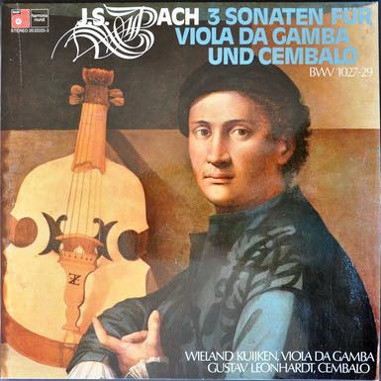 |
|
1 LP -
20 22225-3 - (p) 1974
|
 |
| 1 CD -
GD 77044 - (c) 1989 |
|
DREI SONATEN
FÜR VIOLA DA GAMBA UND CEMBALO
|
|
|
|
|
|
|
|
| Johann Sebastian
BACH (1685-1750) |
Sonate
G-dur, BWV 1027
|
|
13' 58" |
|
|
- Adagio
|
4' 03" |
|
A1 |
|
- Allegro ma
non tanto
|
3' 58" |
|
A2 |
|
- Andante |
2' 47" |
|
A3 |
|
- Allegro moderato |
3' 19" |
|
A4 |
|
Sonate
D-dur, BWV 1028 |
|
15' 48" |
|
|
- Adagio |
2' 02" |
|
A5 |
|
- Allegro
|
4' 01" |
|
A6 |
|
- Andante
|
5' 20" |
|
B1 |
|
- Allegro |
4'
25"
|
|
B2 |
|
Sonate
g-moll, BWV 1029 |
|
16' 11" |
|
|
- Vivace
|
5' 28" |
|
B3 |
|
- Adagio
|
6' 50" |
|
B4 |
|
- Allegro
|
3' 53" |
|
B5 |
|
|
|
|
|
Wieland KUIJKEN,
Viola da gamba (anon.
Süddeutschland, 18. Jahrh.)
Gustav LEONHARDT, Cembalo
(Martin Skowroneck, Bremen 1962,
nach J. D. Dulcken, Anvers, 1745)
Augenommen im tiefen Kammerton
|
|
|
|
|
|
Luogo
e data di registrazione |
|
Schloß Wannegem-Lede
(Berlgien) - 15/17 maggio 1974
|
|
|
Registrazione: live
/ studio |
|
studio |
|
|
Recording
Supervision |
|
Dr. Thomas Gallia |
Paul Dery
|
|
|
Engineer |
|
Sonart, Milano
|
|
|
Prima Edizione LP |
|
Harmonia Mundi (Basf)
| 20 22225-3 | 1 LP - durata 46'
26" | (p) 1974
|
|
|
Edizione CD |
|
Deutsche
Harmonia Mundi | LC 00761 |
GD 77044 | 1 CD - durata 46'
26" | (c) 1989 | ADD
|
|
|
Cover Art
|
|
-
|
|
|
Note |
|
- |
|
|
|
|
Bach probably
wrote his three sonatas for
viola da gamba and cembalo
between 1717 and 1723, while
he was Kapellmeister at the
Cöthen court. The reasons
are clear: Bach's employer,
Prince Leopold of
Anhalt-Köthen, was himself
an amateur gamba player.
Bach was probably thinking
of him when he included two
obbligato viola da gamba
parts in the 6th Brandenburg
Concerto. Solo sonatas for
the Prince's favourite
instrument were an obvious
bonus.
In the six years at Cöthen -
when Bach was in his middle
thirties - most of the
instrumental works came into
being: sonatas and concertos
in the Italian style, and
suites in the French style
for different instruments in
addition to the first book
of the Well-Tempered
Clavier. All forms of
instrumental music current
at the period were tried
out, to explore their limits
in ever new and different
ways. Bach's tremendous
imagination reveals itself
in his capacity to react to,
and transform, existing
forms, as even his
contemporaries recognized.
Indeed, even he was cantor
at St. Thomas in Leipzig -
and this is particularly
true of his instrumental
music - Bach nowhere broke
out of the established
musical forms of his time,
although he was able in the
partitas, variations and
fugues of the later period
to create a musical world
which combined mathematical
rules of proportion,
cabbalistic number-play, the
greatest freedom of
invention, daring harmonic
progression and depth of
expression. But thus far -
in Cöthen - these limits
have not yet been reached.
The traditional forms of the
"sonata da chiesa" with its
four movements (slow - fast
- slow - fast) and the
"concerto" (on Vivaldi's
model) with its three
movements (fast - slow -
fast) provide a basis in the
gamba sonatas for inventive
trio playing. The G major
sonata, however, must be
placed somewhat earlier,
particularly since it finds
an earlier form in the
sonata for two flutes and
bass. The viola da gamba has
taken over the part of the
second flute; the
transposition down an octave
makes the overall sound more
transparent.
The two other sonatas appear
more modern; the D major,
because, especially in the
second and fourth movements,
it most strongly breaks
through the principle pf the
"trio", and the G minor,
because in it the
three-movement concerto form
has been reached. Otherwise,
in some of their rhythmic
figurations and in their
instrumental treatment, both
sonatas are reminiscent of
the 3rd and 5th Brandenburg
concertos, which helps to
settle the question of when
they were written with some
precision. Particular
attention is drawn to a
reminiscence of the third
movement of the D minor
cembalo concerto in the
first movement of the G
minor sonata.
But all these points are of
a formal kind. If one thinks
of the early organ works,
bristling with genius, which
were able to put a
congregation in confusion
and which so much disturbed
the church elders in
Arnstadt, and if one
remembers the timeless works
of the later period, which
surge like erratic blocks of
highly intellectual art into
a period characterized by a
"style galant", then we must
regard our three sonatas,
like the Brandenburg
concertos, as being "up to
date". With their mixture of
elegance and thoroughness,
they make room for music
which was intended to
"delight the soul" and was,
for the connoisseur,
simultaneously "practice"
and "galanterie".
W.
W.
|
  |
|
|